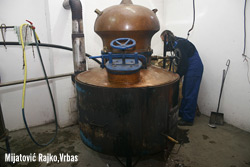Rakia Bar, since 2006
Home / About rakia / Brandy production
Brandy production
A short review of general information
Alcohol is an organic compound which contains a hydroxyl group (e.g. methanol CH 3 -OH or ethanol CH 3 -CH 2 -OH).
Fermentation is a process through which organic substances ( usually carbohydrates ) are transformed into alcohols by means of single-celled organisms.
Brandy is obtained through the process of distillation, in which the fermented liquid mixture is heated, alcohol is extracted in the form of vapour and then it is again transformed into liquid condition by cooling. Alcohol is extracted from the mixture as a compound with a lower boiling point. Alcohol contents in a pre-distilled liquid can be increased by repeated distillations, with the reduction of the total volume of liquid.
Fermentation is a process through which organic substances ( usually carbohydrates ) are transformed into alcohols by means of single-celled organisms.
Brandy is obtained through the process of distillation, in which the fermented liquid mixture is heated, alcohol is extracted in the form of vapour and then it is again transformed into liquid condition by cooling. Alcohol is extracted from the mixture as a compound with a lower boiling point. Alcohol contents in a pre-distilled liquid can be increased by repeated distillations, with the reduction of the total volume of liquid.
Apparatus
The apparatus used to distill brandy from fermented liquid usually consists of a cauldron which is connected to an upright vapour tube to which alcohol vapours leave during the process of heating.The vapour tube leads to the condenser where the complete condensation of alcohol vapours into liquid condition takes place, by means of a cold water current.
The apparatus that is used for brandy production is usually made of copper.
The apparatus that is used for brandy production is usually made of copper.
Production

Although the process of distilled beverages production is known from the ancient times, new technologies make it possible to produce brandies of increasingly better quality. The technological process of brandy production consists of four basic stages, which are:
- grinding, fine cutting or crushing of fruits
- fermentation or alcohol boiling – transformation of carbohydrates into alcohol and carbon dioxide (CO 2), by means of micro-organisms and sometimes with the addition of yeast
- distillation – the technological operation in which alcohol is extracted from the fermented mixture
- aging – brandy is poured into oak barrels where it is stored from two to twelve years. During that period, the taste, aroma and colour of a particular sort of brandy are developed.
Quality

The popular myth has it that brandy force can be determined by the size of the bottle rings i. e. garlands that are made when the bottle is well shaken. This measure is wrongly used to gauge brandy quality.
Brandy in Serbia is most commonly made of plums because annual yields and domestic plums quality make it possible. Besides plum brandy, brandies in Serbia are made from apricots, quinces, pears, apples, raspberries, as well as of honey, nuts and other fruit.
Although it is not a rule, the usual strength of the brandies made of fruit is as follows:
plum brandy 40-45 vol % alcohol
apple brandy 42 vol% alcohol
pear brandy 40-45 vol% alcohol
apricot brandy 45-50 vol% alcohol
peach brandy 45-50 vol% alcohol
grape brandy 50 vol% alcohol
marc brandy 50 vol% alcohol
The quality and main characteristics of brandy have to be checked and confirmed by laboratories specially equipped to do such analyses and with legal capacity to issue valid certificates about brandy quality.
Brandy in Serbia is most commonly made of plums because annual yields and domestic plums quality make it possible. Besides plum brandy, brandies in Serbia are made from apricots, quinces, pears, apples, raspberries, as well as of honey, nuts and other fruit.
Although it is not a rule, the usual strength of the brandies made of fruit is as follows:
plum brandy 40-45 vol % alcohol
apple brandy 42 vol% alcohol
pear brandy 40-45 vol% alcohol
apricot brandy 45-50 vol% alcohol
peach brandy 45-50 vol% alcohol
grape brandy 50 vol% alcohol
marc brandy 50 vol% alcohol
The quality and main characteristics of brandy have to be checked and confirmed by laboratories specially equipped to do such analyses and with legal capacity to issue valid certificates about brandy quality.